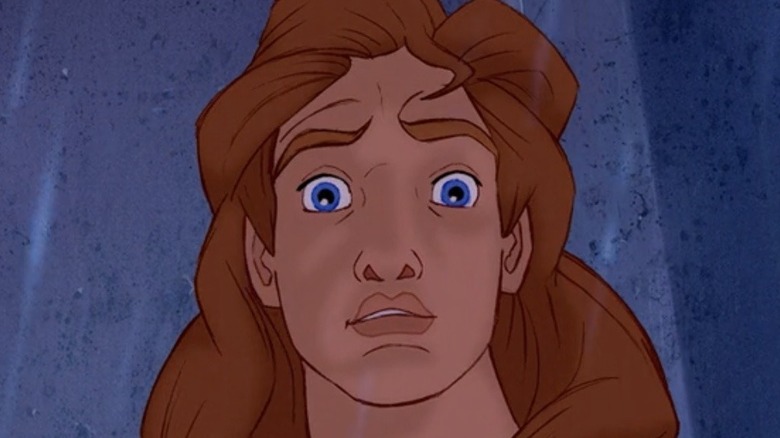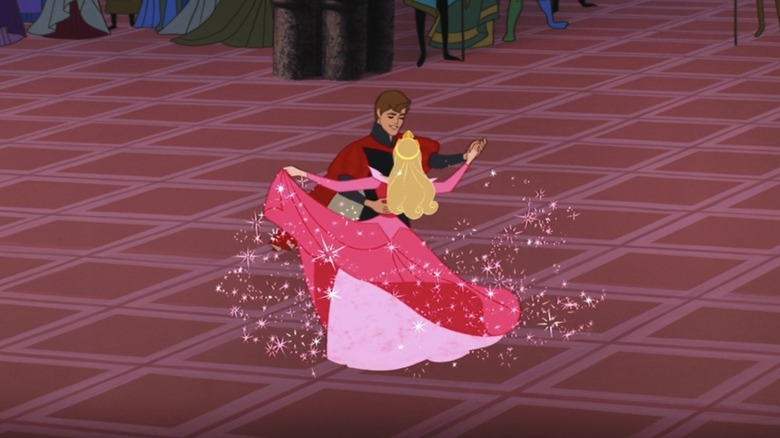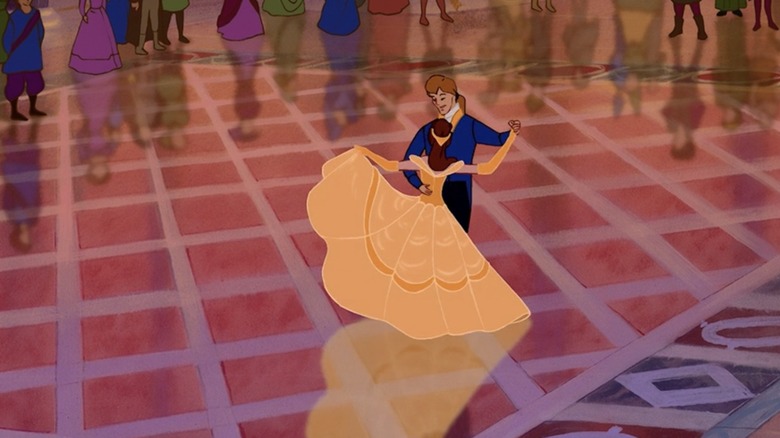The Scene Beauty And The Beast Stole From Sleeping Beauty
The 1980s, in Disney history, is often referred to as the "dark ages." It was a period in which the studio saw high turnover, darker storylines, and a run of movies that didn't achieve major success — think 1985's "The Black Cauldron" and 1988's "Oliver and Company." That all changed with "The Little Mermaid," in 1989, which launched a decade of iconic 1990s Disney movies, and the quality of this so-called Disney Renaissance — with films that featured celebrity voices, Broadway-style acts, and major musical numbers — is perfectly embodied in the 1991 release of "Beauty and the Beast."
While Disney's renaissance era was a time of change, though, you could say that the success of films like "Beauty and the Beast" (not to mention the studio's recent slate!) is due to the fact that the company's animation division learned to innovate while also staying true to their roots. Past Disney projects have informed newer ones in large and small ways — consider, for example, how "Enchanted" drew from "Cinderella" and "Snow White" and "Sleeping Beauty" (via USA Today). This went so far as recycling scenes: movies like "Snow White" and "Robin Hood," though created decades apart, featured sections that were surprisingly alike.
And nowhere is that truer than with "Beauty and the Beast," which deliberately cribbed a very important scene from 1959's "Sleeping Beauty."
The ballroom dance scenes in the two films are basically identical
The scene — in both movies — comes following the conclusion of each film's most climactic sequence: a dance within a castle ballroom.
In "Sleeping Beauty," Prince Phillip has dispatched Maleficent (as a dragon) with a sword enchanted by those heroic fairies, Flora, Fauna, and Merriweather, and the residents of the castle have woken up to find the prince escorting Princess Aurora down the castle steps. After surprising their parents, Phillip sweeps Aurora into an effortless dance across the ballroom floor, even though no one else appears to be moving. Aurora's dress keeps changing from pink to blue, thanks to Flora and Merriweather's magical battle over her fashion.
In "Beauty and the Beast," meanwhile, the scene happens after the Beast and Belle have been reunited, Gaston has been dispatched, and the Beast has changed back into the human prince he was before the enchantress cursed him. The two get dressed up in their ballroom finery, with Belle in that iconic yellow dress, and do the exact same effortless sweep across the castle floor, in the midst of non-moving onlookers, just before the credits roll. Unlike with Aurora, Belle's dress doesn't keep changing color, so she isn't constantly surrounded by sparkles. However, reflections in the floor add a bit more depth than in the "Sleeping Beauty" version, showcasing perhaps the strides animation took in the 32 years between the two films.
The creators of Beauty and the Beast admitted to redrawing the scene
It turns out that those involved in "Beauty and the Beast" were very aware of a man named Woolie Reitherman, who directed movies like "101 Dalmations" and "The Aristocats," and was responsible for many of the repeating scenes found in Disney films. At least, that's according to Disney legend Floyd Norman (per the Walt Disney Archives), who also worked on many of those films.
The recycling was a conscious decision, not laziness. In fact, Norman told GeekDad in 2015 that recycling the animation was actually a greater challenge. "It's actually harder and takes longer to redraw an existing sequence [...] It's a lot faster and easier to just do new animation, and it's a lot more fun for the animators. But Woolie liked to play it safe and use stuff he knew would work. That's all it was."
So, as "Beauty and the Beast" was nearing its delivery deadline, its crew decided to take a cue from Reitherman and use this time-honored means of reducing costs. In 2015, co-director Gary Trousdale added that, with staff preoccupied with numerous tasks already, they decided to follow the example of Woolie Reitherman and reuse the "Sleeping Beauty" animation sequence, with the characters changed over. This "borrowing" from "Sleeping Beauty" was also confirmed in the DVD audio commentary for "Beauty and the Beast," which was done by directors Kirk Wise and Trousdale, plus producer Don Hahn and composer Alan Menken. They admitted that they cleaned up the original animation and changed the characters. One of them quipped, "Sometimes you gotta do what you gotta do."


